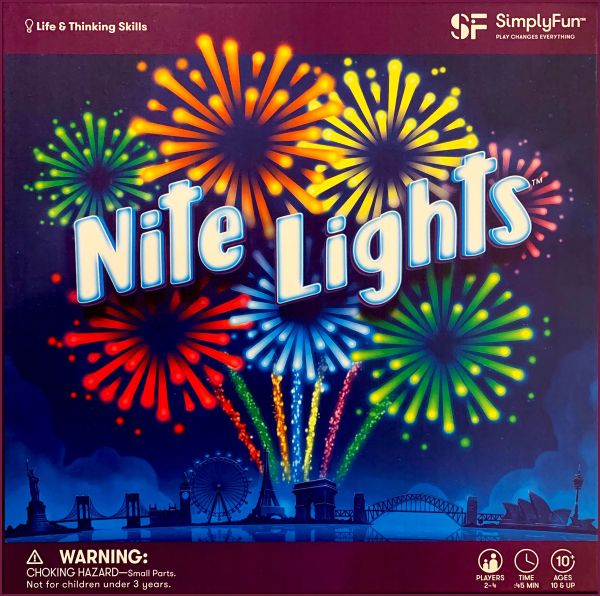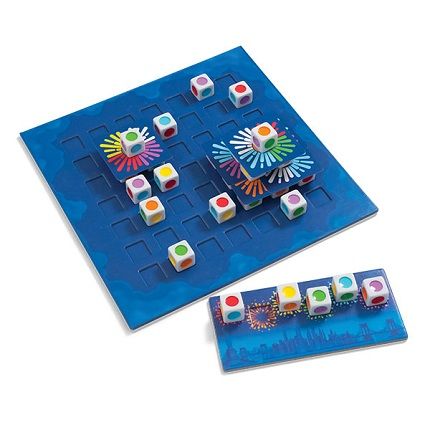Light Up the Sky and Game Board in Nite Lights

Try to build color patterns around the board in order to play cards and put on a colorful light display.
Published by SimplyFun back in 2018, the game may be a few years old but it is still well worth taking a look at.
Gameplay
The game board is set in the middle of the table. This shows a grid of indented spaces that dice can be placed in. Each player takes a skyline board on which they place six dice, each one showing a different one of the six colors in the game. These are your show blocks. Each player is then dealt five cards, which they lay face-up in front of themselves. Each card has a colored circle in the middle and is divided into four quadrants, each quadrant showing a color.
On your turn you may either draw a die from the bag and place it on one of the spaces on the board, keeping whichever color you choose face-up, or you may rotate any die on the board to show any color you would like. You cannot rotate a die that was just placed or rotated by the previous player. Then you can check to see if you can play one of your cards.
In order to play a card, you must be able to place it on top of four dice, each of which shows the same color as the quadrant of the card that will be placed on top of it. If the quadrant is white, it is wild and can be placed on top of any color. Other cards can also be used to match colors for your card. So, for example, you might be able to play a card matching two of the quadrants onto two dice, and the other two quadrants on two quadrants of an adjacent card. In fact, a single card can be played if it matches one or more other cards on the board, not using any dice at all. However, when playing a card, all the dice and/or cards it is matching to must be on the same level of the game board. As you play more dice and cards, the game board can grow multiple levels high. A card must also completely cover any dice it is being laid on top of.
When you place a card, you then check the colored circle in the center of the card. If it matches one of the colors you still have on your skyline board, you may then place that matching show block on top of the card. If the colored circle is white, you may place any colored show block on it. If you do not have a matching show block, then you draw a die from the bag and place it on the circle, showing the correct color.
Once you have played a card, you get to draw a new one. If you placed a card on level two or higher of the game board, you also get a bonus turn, and get to go again.
The first player to play all their show blocks wins the game.

Review
Nite Lights is an enjoyable puzzle with simple, easy-to-learn mechanics. It’s quite visually appealing, as dice and cards start building a multi-level game board. It’s satisfying when you manage to plan ahead effectively and play a card or when you’re able to piggyback off an opponent’s move.
There’s some trying to block other players and make it more difficult for them to place cards, so that you’re keeping an eye out on their options as well as your own. In the beginning, you have a huge board to work with so it’s harder to block each other, but as the game continues this becomes more feasible, especially as players begin to concentrate more on placing specific show blocks and therefore completing specific cards.
Due to the placement of the card and dice, as you start to build up the levels, it can be a little fiddly to place new cards, and sometimes you have to pick up dice to place new cards. This problem escalates the more crowded the board gets, which can be frustrating and slows down the otherwise simple and accessible gameplay. This is going to be even more difficult when playing with children or anyone who struggles with hand-eye coordination.
There are also a few points in the rulebook that could be more clearly presented, but they’re at least questions that become clearer as you play the game.
Nite Lights has a great table presence, is an engaging puzzle, and has a nice element of player interaction. It would be improved with slightly less fiddly gameplay, but it’s still quite enjoyable, turns are fast, and players always have solid options at their disposal each turn.
Pros: Enjoyable puzzle, some player interaction, easy to learn
Cons: Placing cards can be quite fiddly, rulebook could be a little clearer
Disclosure: we received a complimentary review copy of this game.






